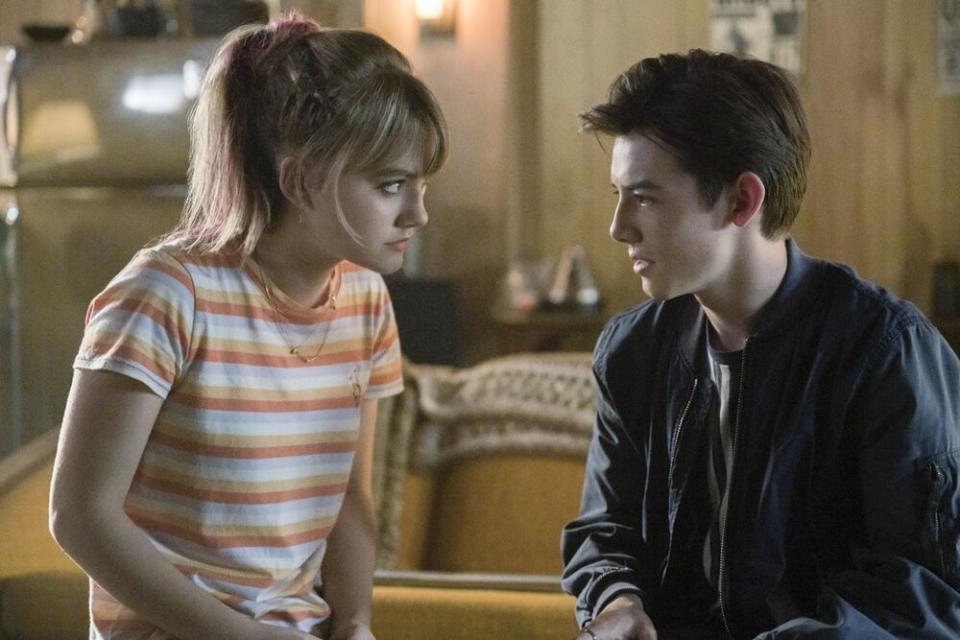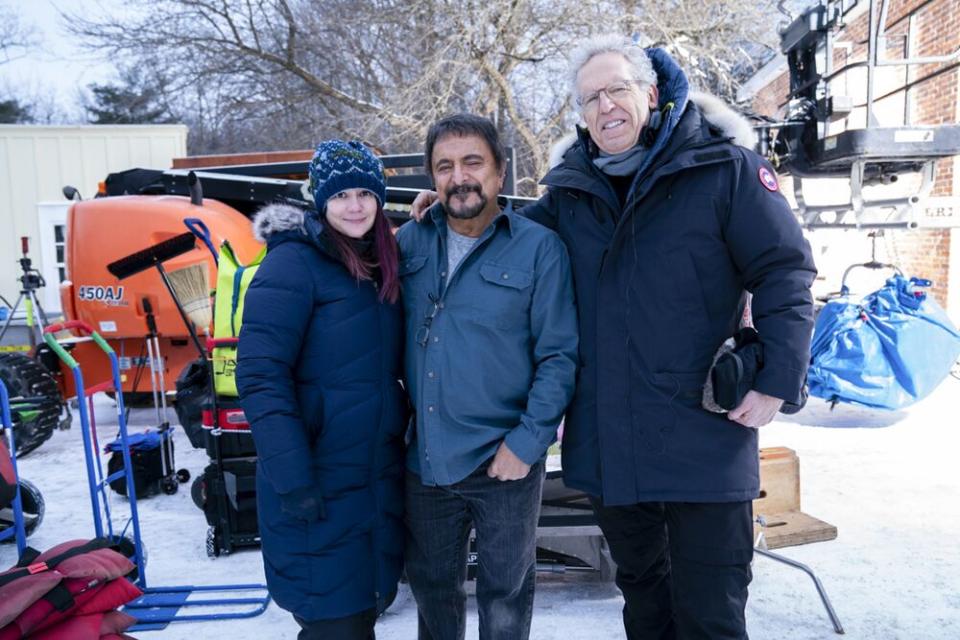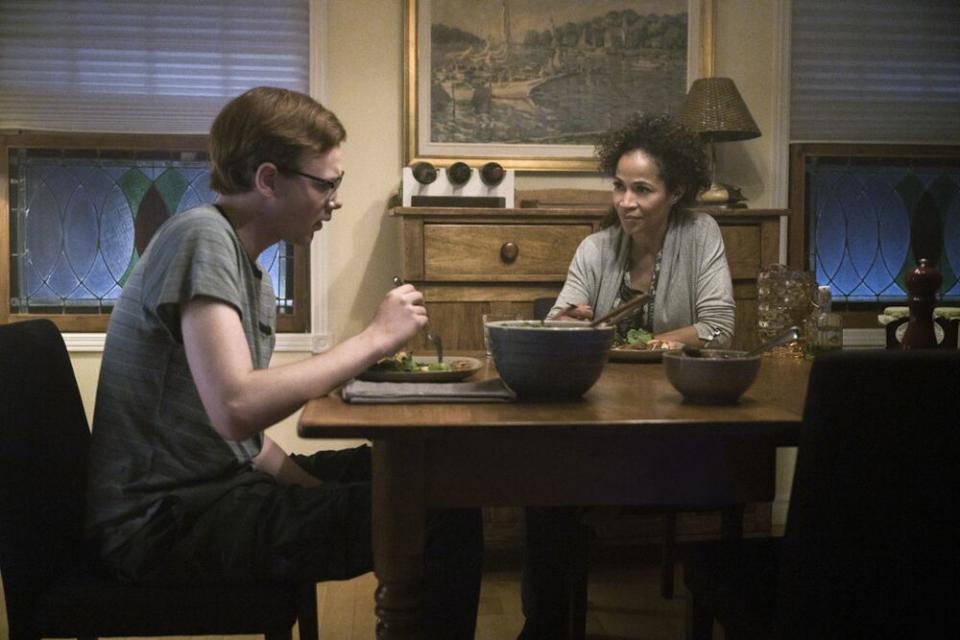Locke Key showrunners Carlton Cuse and Meredith Averill explain that finale twist, answer burning questions

Warning: This article contains spoilers about the season 1 finale of Locke & Key.
Well, how about THAT twist, huh?
The new Netflix series Locke & Key is based on a comic book of the same name created by Joe Hill and Gabriel Rodriguez. Any viewers familiar with the source material may have noticed a significant difference in character dynamics on the show. While the demonic Dodge spent most of the original Locke & Key comic disguised as Zack Wells, a friend of the Locke children, the show’s version of Dodge only ever appeared in her female form in a villainous capacity…until the final episode, that is.
The last moments of Locke & Key season 1 revealed that Dodge had been hiding in plain sight the whole time…only here she took the name Gabe (Griffin Gluck) instead of Zack. If you look back at the tape, it checks out: Though Kinsey Locke (Emilia Jones) met Gabe through the horror-obsessed “Savini Squad,” Gabe wasn’t with the friend group when Kinsey first hung out with them. It wasn’t until after Dodge escaped the wellhouse using the Anywhere Key at the end of the first episode that Gabe appeared at the next Savini shoot — in a lobster costume, offering Kinsey “craft service” in the form of Cheez-Its. As Scot Cavendish (Petrice Jones) explained at the time, “Gabe’s new to Matheson too, so we offered him friendship in exchange for wearing a suit that doesn’t breathe.” Whoops!
After previously talking with Locke & Key co-showrunner Carlton Cuse about the making of the show, EW caught up with Cuse and co-showrunner Meredith Averill (The Haunting of Hill House) to discuss the finale’s revelations and what’s next for Keyhouse.

ENTERTAINMENT WEEKLY: Dodge is Gabe! Dodge has not been thrown through the Black Door. Speaking of, how did you guys set up that reveal?
CARLTON CUSE: We wanted to have a big twist at the end. We loved the idea of Dodge having multiple identities like in the comic, but we felt like this version worked better for the TV series. Joe embraced it when we pitched it to him. For a variety of reasons it just felt like this was good. It’s also great in the sense that if you’re a fan of the comic you do get a surprise, it’s not like everything is laid out for you or happens just like it does in the book. Just to be specific: Gabe is always Dodge. Gabe is an identity created by Dodge. This is not something you missed, this is just something we’re clarifying. The Identity Key allows you to assume a new identity, but not the identity of an existing person. Every time Gabe exists in our story, it is as Dodge. Our little trip down memory lane at the end was a way to try and explicate that for the audience.
The Crown of Shadows is one of the craziest keys from the comic, and finally makes its debut in the finale. How did you guys approach adapting that key and all its living shadows, while also working in this elaborate body switch Dodge does with Ellie (Sherri Saum)?
MEREDITH AVERILL: We always knew that we wanted to build to a Crown of Shadows attack at the end of the season. It’s just such an epic, epic key. It makes for such an epic moment when Dodge comes up the driveway wearing the crown and the shadows come up from underneath and flip the car. We always knew we wanted that. But it was definitely one of the more challenging keys, especially from a visual effects standpoint, to pull off. Luckily we had an incredible director in Vincenzo Natali, who we collaborated with on this. He storyboarded this incredible sequence, which really helped us visualize it — the cast as well was helped by looking at the storyboards and knowing exactly what they were responding to. It was a lot of choreography. You watch it, and it came out amazing, but it was difficult even in the writers’ room to get the choreography down exactly like: Okay, where is the actual Dodge who is wearing the crown, versus where is Shadow Dodge created by the crown? She has a plan all perfectly laid out and it works exactly as she hoped. You see that brief moment of Bode and Tyler running up the stairs, and you see just for a split second of Dodge wearing the crown. What you see later is that what she went and did is, she had Ellie’s body just waiting outside the front door for her to drag it in at the perfect moment. It was a lot of tricky choreography, but I think we really pulled it off. We love the visual effects: When you actually get to see Dodge in her actual demonic form for the first time when she screams at Bode (Jackson Robert Scott), I’m so proud of our team for that.
It’s tricky because you want everyone to be clever. You want our heroes to think they’ve defeated her, but also Dodge outsmarted them. Our writers’ room knocked it out of the park.

Poor Ellie got thrown through the Black Door in Dodge’s place. Is there a possibility we will ever see her again?
CUSE: We don’t have season 2 picked up yet, but we are working on the writing. Let’s just say there is more to come on that whole story line. It’s not fully resolved. We don’t want to say too much without spoiling anything, but we’re definitely conscious of the reaction people will probably have to the end of the first season, and will want to know more about what happened there.
In addition to that twist ending, the finale also gives us that lovely scene of Nina Locke (Darby Stanchfield) and the kids around the table. What did you like about that as a resolution to Nina’s arc and the familial dynamic they’ve had over the season?
AVERILL: I love that scene, it’s one of my favorites over the season. Darby is so fantastic in it. It’s a beautiful scene because it’s a flip of when they first arrive, when she’s really wanting to put down roots here and make it a home, while they are so wanting to be anywhere else. Now you have her ready to move on because she thinks she’s made this horrible decision, only to learn that the kids, because of everything they’ve been through, have embraced the place and what it meant to their father. So much of the show is about adults and kids not communicating, so it feels like this is a scene where they’re actually talking and telling each other how they feel. You don’t get a ton of those scenes because everyone’s walking around with barriers up, but this is a scene where everyone’s so open. I thought it was a fantastic scene to end our family story on, and have them decide to really commit to their new life in Matheson.
How did you guys get that flesh sound for the keys that turn in a face rather than a door, like the Identity Key? It’s such a creepy, gruesome sound effect. What’s the story there?
CUSE: That’s our producer, Ra’uf Glasgow. I’ve worked with him since Lost. He was responsible for creating a lot of the iconic sounds in Lost. It’s just a special skill that he has, from flashback whooshes to the sound of vampires in The Strain, to the key sounds. Ra’uf spent a lot of time with sound designers on how to articulate fantasy in terms of sound. That’s something you don’t think about a lot. We think about fantasy in terms of visual imagery. But the sounds of fantasy are just as important. He’s responsible for coming up with those sounds like that. When Meredith and I heard them, we were super happy.

I really like the depiction of Rufus in the show. The writers and actor Coby Bird really captured what I loved about the character in the comic. What were you guys conscious of when translating him to the screen?
AVERILL: It was important to us to cast an actor with a mental disability. We asked our amazing casting director, April Webster, to go on a huge, huge search. We saw a lot of different actors, and as soon as we saw Coby’s audition (and his reel, he had done some guest roles on shows like The Good Doctor), we just felt he had so much warmth to him. He really had exactly what Rufus has on the page. We just believed in him and Bode’s friendship so much. Coby has autism, and we think it was really important to us to cast it that way. Coby did such an amazing job on the show. Similarly to your question about Ellie, we hope to tell stories with him in the future. It feels like his friendship with Bode is really special and important to the show. There are stories in the comics that we haven’t had a chance to tell featuring Rufus that we would love to tell in the future.
We’ve seen the Black Door, we’ve seen the Omega Key, so you guys were able to put a lot from the comics into the first season. But there’s still more left. Without spoiling, when you look at what stories are left to tell from the comics and what new possibilities there are from what the show has become, what excites you about looking to the future?
CUSE: The amazing thing about Joe and Gabriel’s comic is how much stuff there is in there. I think that was both the thing that excited both of us, and also was the heart of the challenge: How to tackle all these elements? There’s a murder mystery, there’s family drama, there’s teen drama, there’s fantasy, there’s horror. We had to figure out how to combine those things in a way that honored all of them and didn’t feel too disparate. The great thing about TV is when you start down a path it becomes an organic, living, breathing entity. We love so many of the relationships that have been created. So many possibilities arose from what we did in season 1 that we have a pretty good road map for season 2, so hopefully we get an official pick-up. Once we finish season 2, that will tell us about the longevity of the show overall. Right now it feels like, our goal is nothing less than making season 2 even better than season 1. I think that’s an achievable goal.
Related content:

